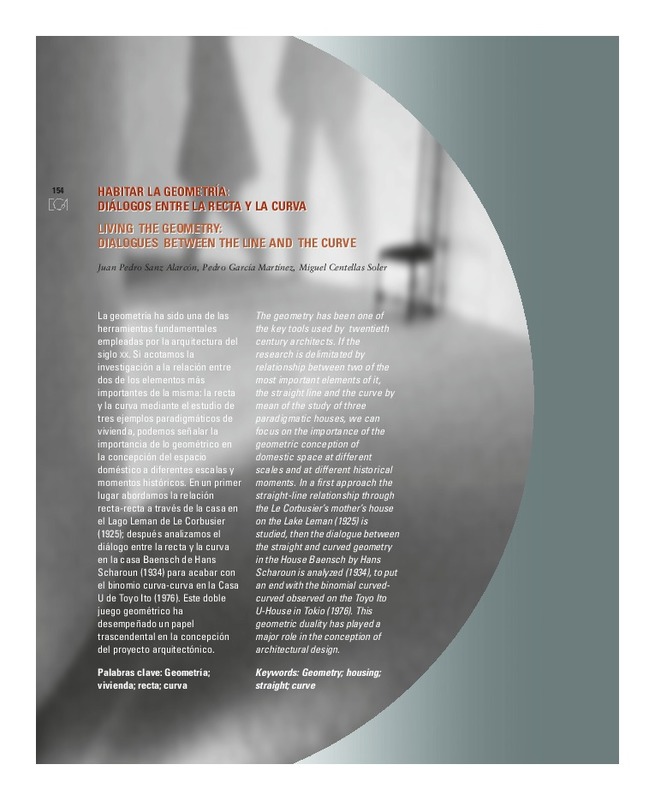JavaScript is disabled for your browser. Some features of this site may not work without it.
Buscar en RiuNet
Listar
Mi cuenta
Estadísticas
Ayuda RiuNet
Admin. UPV
HABITAR LA GEOMETRÍA: DIÁLOGOS ENTRE LA RECTA Y LA CURVA
Mostrar el registro sencillo del ítem
Ficheros en el ítem
| dc.contributor.author | Sanz Alarcón, Juan Pedro
|
es_ES |
| dc.contributor.author | García Martínez, Pedro
|
es_ES |
| dc.contributor.author | Centellas Soler, Miguel
|
es_ES |
| dc.date.accessioned | 2013-03-01T08:20:26Z | |
| dc.date.available | 2013-10-23T22:30:51Z | |
| dc.date.issued | 2012 | |
| dc.identifier.issn | 1133-6137 | |
| dc.identifier.uri | http://hdl.handle.net/10251/27411 | |
| dc.description.abstract | [EN] The geometry has been one of the key tools used by twentieth century architects. If the research is delimitated by relationship between two of the most important elements of it, the straight line and the curve by mean of the study of three paradigmatic houses, we can focus on the importance of the geometric conception of domestic space at different scales and at different historical moments. In a first approach the straight-line relationship through the Le Corbusier¿s mother¿s house on the Lake Leman (1925) is studied, then the dialogue between the straight and curved geometry in the House Baensch by Hans Scharoun is analyzed (1934), to put an end with the binomial curvedcurved observed on the Toyo Ito U-House in Tokio (1976). This geometric duality has played a major role in the conception of architectural design. | es_ES |
| dc.description.abstract | [ES] La geometría ha sido una de las herramientas fundamentales empleadas por la arquitectura del siglo XX. Si acotamos la investigación a la relación entre dos de los elementos más importantes de la misma: la recta y la curva mediante el estudio de tres ejemplos paradigmáticos de vivienda, podemos señalar la importancia de lo geométrico en la concepción del espacio doméstico a diferentes escalas y momentos históricos. En un primer lugar abordamos la relación recta-recta a través de la casa en el Lago Leman de Le Corbusier (1925); después analizamos el diálogo entre la recta y la curva en la casa Baensch de Hans Scharoun (1934) para acabar con el binomio curva-curva en la Casa U de Toyo Ito (1976). Este doble juego geométrico ha desempeñado un papel trascendental en la concepción del proyecto arquitectónico. | es_ES |
| dc.language | Español | es_ES |
| dc.language | Inglés | |
| dc.publisher | Editorial Universitat Politècnica de València | es_ES |
| dc.relation.ispartof | EGA. Revista de Expresión Gráfica Arquitectónica | |
| dc.rights | Reserva de todos los derechos | es_ES |
| dc.subject | Geometría | es_ES |
| dc.subject | Vivienda | es_ES |
| dc.subject | Recta | es_ES |
| dc.subject | Curva | es_ES |
| dc.subject | Geometry | es_ES |
| dc.subject | Housing | es_ES |
| dc.subject | Straight | es_ES |
| dc.subject | Curve | es_ES |
| dc.title | HABITAR LA GEOMETRÍA: DIÁLOGOS ENTRE LA RECTA Y LA CURVA | es_ES |
| dc.title.alternative | LIVING THE GEOMETRY: DIALOGUES BETWEEN THE LINE AND THE CURVE | es_ES |
| dc.type | Artículo | es_ES |
| dc.date.updated | 2013-02-15T13:01:31Z | |
| dc.identifier.doi | 10.4995/ega.2012.1413 | |
| dc.rights.accessRights | Abierto | es_ES |
| dc.description.bibliographicCitation | Sanz Alarcón, JP.; García Martínez, P.; Centellas Soler, M. (2012). HABITAR LA GEOMETRÍA: DIÁLOGOS ENTRE LA RECTA Y LA CURVA. EGA. Revista de Expresión Gráfica Arquitectónica. 17(20). https://doi.org/10.4995/ega.2012.1413 | es_ES |
| dc.description.accrualMethod | SWORD | es_ES |
| dc.relation.publisherversion | https://doi.org/10.4995/ega.2012.1413 | es_ES |
| dc.description.upvformatpinicio | 154 | |
| dc.description.volume | 17 | |
| dc.description.issue | 20 | |
| dc.identifier.eissn | 2254-6103 |








